造成家禽肾脏病变的九种常见病的鉴别诊断
- 格式:doc
- 大小:16.00 KB
- 文档页数:3
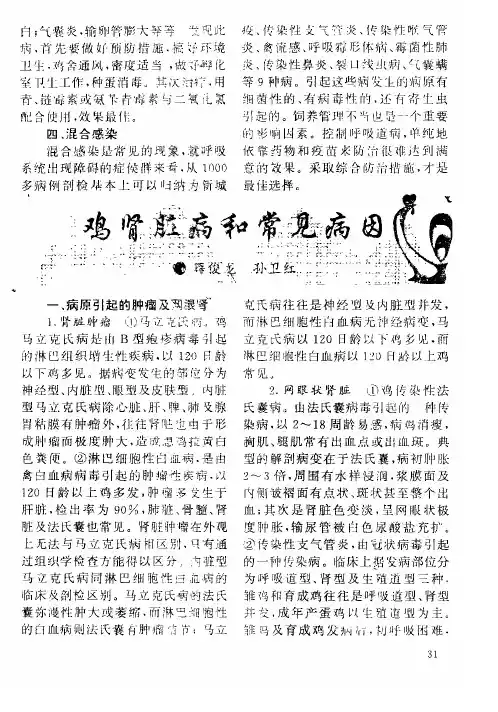
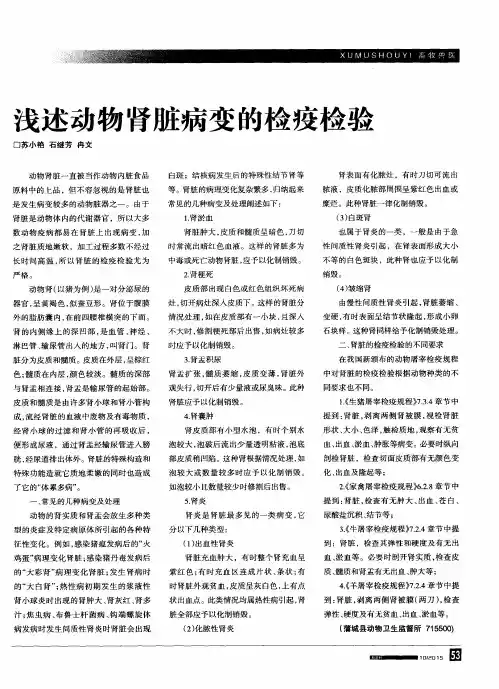
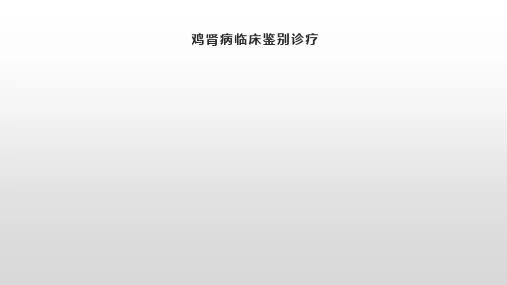
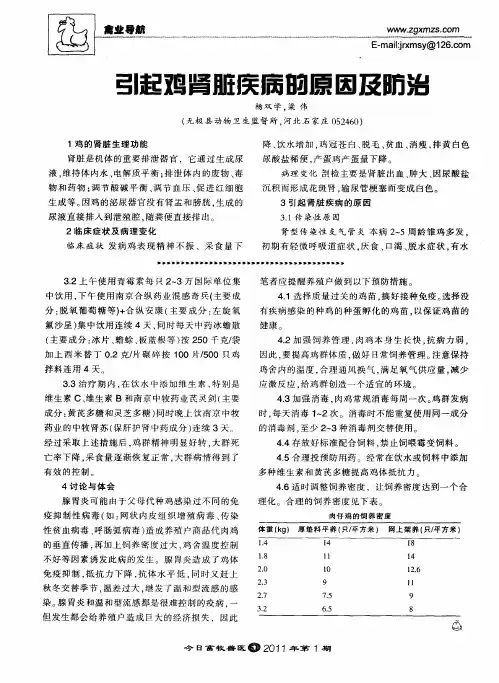
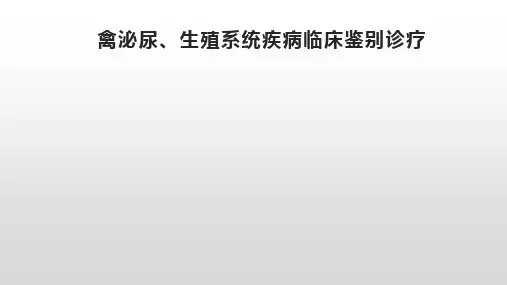
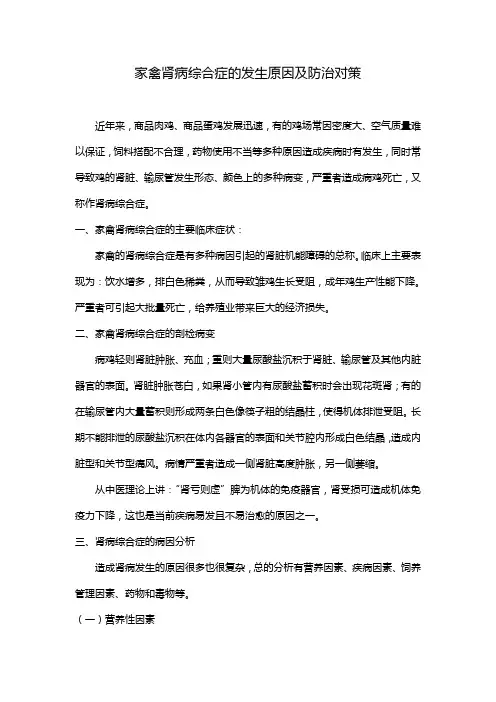
家禽肾病综合症的发生原因及防治对策近年来,商品肉鸡、商品蛋鸡发展迅速,有的鸡场常因密度大、空气质量难以保证,饲料搭配不合理,药物使用不当等多种原因造成疾病时有发生,同时常导致鸡的肾脏、输尿管发生形态、颜色上的多种病变,严重者造成病鸡死亡,又称作肾病综合症。
一、家禽肾病综合症的主要临床症状:家禽的肾病综合症是有多种病因引起的肾脏机能障碍的总称。
临床上主要表现为:饮水增多,排白色稀粪,从而导致雏鸡生长受阻,成年鸡生产性能下降。
严重者可引起大批量死亡,给养殖业带来巨大的经济损失。
二、家禽肾病综合症的剖检病变病鸡轻则肾脏肿胀、充血;重则大量尿酸盐沉积于肾脏、输尿管及其他内脏器官的表面。
肾脏肿胀苍白,如果肾小管内有尿酸盐蓄积时会出现花斑肾;有的在输尿管内大量蓄积则形成两条白色像筷子粗的结晶柱,使得机体排泄受阻。
长期不能排泄的尿酸盐沉积在体内各器官的表面和关节腔内形成白色结晶,造成内脏型和关节型痛风。
病情严重者造成一侧肾脏高度肿胀,另一侧萎缩。
从中医理论上讲:“肾亏则虚”脾为机体的免疫器官,肾受损可造成机体免疫力下降,这也是当前疾病易发且不易治愈的原因之一。
三、肾病综合症的病因分析造成肾病发生的原因很多也很复杂,总的分析有营养因素、疾病因素、饲养管理因素、药物和毒物等。
(一)营养性因素(1)发病机制:家禽蛋白质的代谢产物与其他动物不同,这是因为家禽肝脏中缺乏精氨酸酶使蛋白质的最终代谢产物为微溶的尿酸盐。
在正常的情况下,机体生成的和排出的尿酸盐是平衡的,当肾脏功能发生障碍时机体排泄尿酸盐的速度减慢,或因某种因素机体内生成大量的尿酸盐时,超出了肾脏正常代谢功能,就造成了微溶的尿酸盐在肾脏内大量蓄积。
(2)发病原因1、如果饲料中蛋白质含量长期严重超标,生成微溶性的尿酸盐含量增多,导致肾脏排泄功能失衡,不能及时排泄出去则沉积于肾脏,造成肾脏肿大苍白、花斑肾。
严重的在内脏器官的表面、输尿管及关节腔可见尿酸盐沉积。
导致鸡只死亡率升高。

蛋鸡肾脏病毒与营养性疾病的诊治肾脏是机体重要排泄器官。
它在鸡的生理过程中所处的地位十分等重要。
肾脏发生疾病能影响正常的生理活动和生产性能,降低养殖效益,降低饲料利用率,加大养殖成本。
因此,正确了解蛋鸡肾脏的生理结构及肾病发生的原因,将有利于现代养蛋鸡业的健康发展。
1病毒性因素1.1传染性法氏囊病主要症状为拉白色稀便如牛奶状,极度怕冷、扎堆,极度虚弱,鸡表现脱水,腿部和胸部肌肉出血,法氏囊肿大如球,法氏囊内粘液增多,粘膜表面有点状。
出血或弥漫性出血,严重者法氏囊内有干酪样渗出物。
5天后法氏囊开始萎缩,肾有不同程度的肿胀,发病鸡肾小管上皮细胞变性,管腔扩张,管腔内有异染性细胞和均质性物质构成的管型,间质有单核和细胞浸润,充血。
肾功能下降,引起尿酸盐在肾脏沉积。
治疗:首先用抗鸡传染性法氏囊的高免卵黄抗体每只鸡0.5-lml。
1.2肾型传染性支气管炎鸡肾型传染性支气管炎,是由传染性支气管炎病毒(IBV)的嗜肾毒株引起。
此病多发生于15-40日龄的雏鸡,死亡率高达40%,它除了具有呼吸道症状,如分泌物增多,气管、支气管充血、出血炎症外,还可见肾肿大、变形、出血、苍白,多数呈斑驳状的“花肾”,肾小管和输尿管因尿酸盐沉积而扩张,输尿管内容物呈白色石灰乳样很明显。
在严重的病例,白色尿酸盐沉积,可见于其他组织器官表面。
治疗:本病无特效治疗药物,免疫接种是本病的关键,免疫程序要根据当地的免疫情况而定。
不要随意推迟免疫程序。
免疫接种时要采用活苗加死苗的方法免疫效果最好。
1.3包涵体肝炎由腺病毒感染引起的肾脏肿大,呈灰白色出血点,典型病变为肝肿胀、质地脆弱易破裂,呈点状或斑马状出血,并见隆起坏死灶,肝脂肪变性。
黄染出血,心、肝内脏器管褪色变黄。
防治:(1)本病无特效治疗方法,主要措施为加强饲养管理,杜绝传染源传人,防止和消除应激因素。
在饲料中补微量元素和复合维生素,增强鸡的抵抗力,加强禽舍和环境消毒;(2)用土霉素原粉500g拌料700斤,连用5-7天,效果较好,预防并发或继发细菌类疾病。
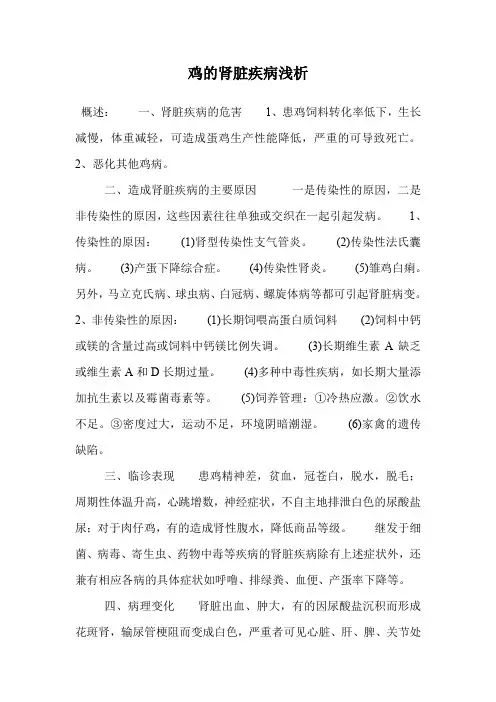
鸡的肾脏疾病浅析概述:一、肾脏疾病的危害1、患鸡饲料转化率低下,生长减慢,体重减轻,可造成蛋鸡生产性能降低,严重的可导致死亡。
2、恶化其他鸡病。
二、造成肾脏疾病的主要原因一是传染性的原因,二是非传染性的原因,这些因素往往单独或交织在一起引起发病。
1、传染性的原因:(1)肾型传染性支气管炎。
(2)传染性法氏囊病。
(3)产蛋下降综合症。
(4)传染性肾炎。
(5)雏鸡白痢。
另外,马立克氏病、球虫病、白冠病、螺旋体病等都可引起肾脏病变。
2、非传染性的原因:(1)长期饲喂高蛋白质饲料(2)饲料中钙或镁的含量过高或饲料中钙镁比例失调。
(3)长期维生素A缺乏或维生素A和D长期过量。
(4)多种中毒性疾病,如长期大量添加抗生素以及霉菌毒素等。
(5)饲养管理:①冷热应激。
②饮水不足。
③密度过大,运动不足,环境阴暗潮湿。
(6)家禽的遗传缺陷。
三、临诊表现患鸡精神差,贫血,冠苍白,脱水,脱毛;周期性体温升高,心跳增数,神经症状,不自主地排泄白色的尿酸盐尿;对于肉仔鸡,有的造成肾性腹水,降低商品等级。
继发于细菌、病毒、寄生虫、药物中毒等疾病的肾脏疾病除有上述症状外,还兼有相应各病的具体症状如呼噜、排绿粪、血便、产蛋率下降等。
四、病理变化肾脏出血、肿大,有的因尿酸盐沉积而形成花斑肾,输尿管梗阻而变成白色,严重者可见心脏、肝、脾、关节处有尿酸盐沉积,如果是继发于其它疾病的尚有呼吸道病变及生殖系统病变。
五、预防与治疗1、加强饲养管理,保证饲料的质量和营养的全价,尤其不能缺乏维生素A。
2、做好肾型传染性支气管炎、传染性法氏囊病等疾病的防治。
3、不要长期或过量使用对肾脏有损害的药物及消毒剂,如磺胺类药物、庆大霉素、卡那霉素、链霉素等。
4、对发病鸡群的治疗:(1)降低饲料中蛋白质的水平,增加维生素的含量,给予充足的饮水,停止使用对肾脏有损害的药物和消毒剂。
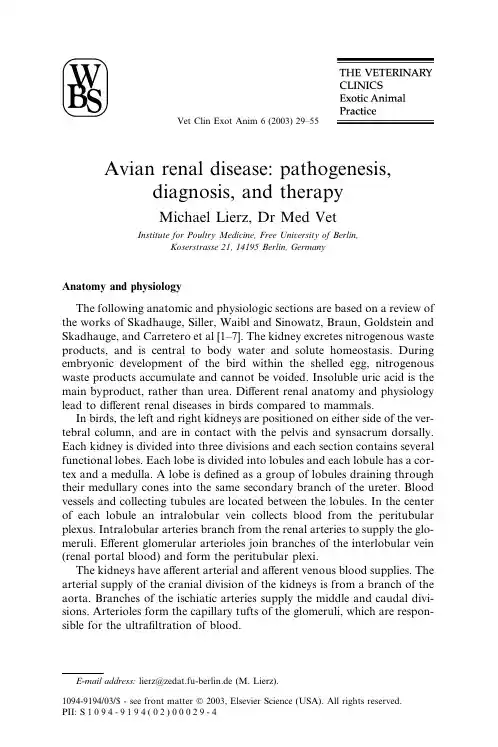
Avian renal disease:pathogenesis,diagnosis,and therapyMichael Lierz,Dr Med VetInstitute for Poultry Medicine,Free University of Berlin,Koserstrasse 21,14195Berlin,GermanyAnatomy and physiologyThe following anatomic and physiologic sections are based on a review of the works of Skadhauge,Siller,Waibl and Sinowatz,Braun,Goldstein and Skadhauge,and Carretero et al [1–7].The kidney excretes nitrogenous waste products,and is central to body water and solute homeostasis.During embryonic development of the bird within the shelled egg,nitrogenous waste products accumulate and cannot be voided.Insoluble uric acid is the main byproduct,rather than urea.Different renal anatomy and physiology lead to different renal diseases in birds compared to mammals.In birds,the left and right kidneys are positioned on either side of the ver-tebral column,and are in contact with the pelvis and synsacrum dorsally.Each kidney is divided into three divisions and each section contains several functional lobes.Each lobe is divided into lobules and each lobule has a cor-tex and a medulla.A lobe is defined as a group of lobules draining through their medullary cones into the same secondary branch of the ureter.Blood vessels and collecting tubules are located between the lobules.In the center of each lobule an intralobular vein collects blood from the peritubular plexus.Intralobular arteries branch from the renal arteries to supply the glo-meruli.Efferent glomerular arterioles join branches of the interlobular vein (renal portal blood)and form the peritubular plexi.The kidneys have afferent arterial and afferent venous blood supplies.The arterial supply of the cranial division of the kidneys is from a branch of the aorta.Branches of the ischiatic arteries supply the middle and caudal divi-sions.Arterioles form the capillary tufts of the glomeruli,which are respon-sible for the ultrafiltration of blood.E-mail address:lierz@zedat.fu-berlin.de (M.Lierz).1094-9194/03/$-see front matter Ó2003,Elsevier Science (USA).All rights reserved.PII:S 1094-9194(02)00029-4Vet Clin Exot Anim 6(2003)29–55A renal portal system with afferent venous blood is important in birds but does not exist in mammals.The external and internal iliac veins and the ischiatic and caudal mesenteric veins collect venous blood from the capillary system of the limb,tail,pelvis,and caudal part of intestine and spine.These vessels combine to form the caudal portal vein.The cranial portal vein (a branch of the external ischiatic vein)and caudal portal vein form a venous ring located ventral to the kidney.The common iliac vein carries venous blood to the caudal vena cava.A renal portal valve is located within the common iliac vein to regulate venous blood flow through the kidney.When the valve is closed,most of the venous blood from the capillary system is directed through the kidney.This happens when the bird is at rest.When the valve opens venous blood is directed into the caudal vena cava,bypassing the kidney (Fig.1).Blood from the venous ring can still bypass the kidney by flowing into the caudal mesenteric vein or internal vertebral venous sinus.Right and left renal portal valves can operate independently.Valvular smooth muscle has sympathetic and parasympathetic enervation.Adrener-gic stimulation causes relaxation of the valve muscles while cholinergic causes contraction.The smooth muscle of the renal portal vein contracts under adrenergic stimulation.These autonomic responses govern flow of renal portal blood.Under sympathetic stimulation the valve is open and blood bypasses the kidney.Parasympathetic stimulation increases valve resistance and blood enters the renal portal system.Afferent venous blood enters the peritubular capillary network to mix with efferent glomerular arteriolar blood.Intralobular veins converge to form the caudal and cranial renal veins proximal to the renal portalvalves Fig.1.Schematic drawing of the avian renal blood supply.The renal portal valve within the common iliac vein regulates the amount of blood shunted into the caudal caval vein.(Courtesy of T.Hoffman,modification of Rickert-Mueller CR.Das Blutgefa ¨sssystem der Niere des Haushuhns (Gallus dom .).Veterinary Thesis,Giessen,Germany;1968.)30M.Lierz /Vet Clin Exot Anim 6(2003)29–55in the common iliac vein.The peritubular capillaries reabsorb large amounts of solute and water from the renal tubules.Birds have two types of nephron.Cortical (reptilian type)nephrons are most common (up to 90%)and are located in the lobule cortex.Their glo-meruli are smaller,and they do not possess the loop of Henle.Medullary (mammalian type)nephrons have long loops of Henle reaching far into the medulla.Bundles of collecting ducts form the rest of the medulla.All lobules in the same lobe drain into the same secondary branch of the ureter,which then joins a primary ureteral branch.All branches of the ureter are lined with mucous-secreting epithelium,and urates are excreted as a colloidal sus-pension.About 65%of uric acid is chemically bound to proteins.Urate pre-cipitates must remain in this supersaturated suspension.Water is needed to flush the suspension through renal tubules.Smooth muscle fibres coordinate ureteral peristaltic motion to move urates towards the cloacal urodeum.Birds have no urinary bladder.Within the mammalian kidney urea concentration (creating hypertonic-ity)within the medulla is the key factor enabling concentration of urine.As urea is not an important product of avian metabolism and loops of Henle are absent in 90%of avian nephrons,the capacity of the avian kidney to concentrate urine is less than mammals.Water is conserved by resorption within the coprodeum and rectumSolutes can be secreted into the renal tubules,adding to the glomerular ultrafiltrate.Uric acid is mainly excreted through this mechanism,and is independent of both ultrafiltration and tubular urine flow.Plasma urate concentration remains normal even if the bird is dehydrated and the renal tubules are full of urate crystals [8–10].Urates are still excreted into the tubules but cannot be flushed through the kidneys due to lack of ureteral water flow (Fig.2).Early and aggressive fluid therapy is needed to reverse the pathologic changes.By contrast,urea is excreted by glomerular filtra-tion.A dehydrated bird may reabsorb up to 99%of tubular water [11].Reduced ultrafiltration following low blood pressure can reduce urea excre-tion.In addition,tubular reabsorption increases during dehydration,as urine flow through the tubules is slow and plasma urea concentration increases [10].The kidneys also regulate potassium and sodium levels.Potassium can be actively reabsorbed or secreted in the distal tubule.Some species,for exam-ple,gloucous-winged gulls (Larus glaucescens ),have salt glands to aid water and electrolyte homeostasis.Calcium is largely reabsorbed while phosphate is mostly excreted.Calcium reabsorption and phosphate secretion is regu-lated by parathyroid hormone,calcitonin,and vitamin D 3[9].Lumbar and sacral nerve plexi are located between the different kidney divisions (Fig.3).The femoral,obturator,and ischiatic nerves have their origins within these plexi.Kidney diseases that cause renomegaly (eg,swell-ing or neoplasia)might lead to pressure on these nerves resulting in lame-ness or leg paralysis (Fig.4)[12].31M.Lierz /Vet Clin Exot Anim 6(2003)29–55Fig.2.Endoscopic view of a filled ureter in a sparrow hawk (a)(Accipiter nisus ).This is a common finding in free-ranging birds found in a dehydrated and debilitated state.Oviduct(b).Fig.3.Schematic view of the nerve plexus located between the three kidney divisions.Swellings or neoplasias of the kidney can increase the pressure on the nerves,leading to limb paralysis (T.Hoffmann,modified from Harcourt-Brown,2000)[46].32M.Lierz /Vet Clin Exot Anim 6(2003)29–55DiagnosisDiagnosis of renal disorders is difficult as pathognomonic signs are rare.In addition,renal disorders are often seen in conjunction with other dis-eases.Some diagnostic tests can provide immediate indication of renal dys-function.In most cases more than one diagnostic test is necessary to confirm a renal disorder and make a definitive diagnosis.Plasma chemistryThe use of plasma chemical parameters to diagnose renal disorders is lim-ited.Reference values are missing or inadequate for most avian species.Reference ranges have been produced for some species,but small numbers of birds have been used and these may have been kept under different con-ditions to the patient.A single parameter falling outside the reference range has limited diagnostic use,and several reasons could explain an aberrant value.Consistent and repeatable abnormal results for several parameters produces a clearer picture and may help direct further investigation such as radiology,endoscopy,and biopsy.Uric acid and ureaUric acid and urea values can be assessed,but normal physiologic varia-tions have to be considered.Postprandial values rise in healthy raptors with peaks up to 8hours after feeding [13].Therefore in raptors a 24-hour fasting period prior to blood sampling is recommended for assessment of renal function.In addition,pathologic increases in uric acid can only be detected if 70%or more of kidney function is lost making this parameter uselessfor Fig.4.Budgerigar (Melopsittacus undulatus )with leg paralysis due to a renal neoplasia.33M.Lierz /Vet Clin Exot Anim 6(2003)29–5534M.Lierz/Vet Clin Exot Anim6(2003)29–55early detection[12].Urea can be used to detect dehydration but not to con-firm renal dysfunction.The ratio of plasma urea and uric acid can be used to differentiate prere-nal and renal causes of azotemia[10].Prerenal azotemia with elevated urea levels produces a high urea:uric acid ratio.The ratio is calculated:plasma urea concentration[mmol/L]Â1000:plasma uric acid concentration[l mol/ L].In peregrine falcons(Falco peregrinus)the ratio is>6.5[10].Such normal ratios must be established for each species.Renal failure is likely when uric acid concentration is above the species reference range in a fasted individual. Severe tissue damage could lead to an increased uric acid concentration fol-lowing release of nucleic acids[14].CreatinineCreatinine has limited diagnostic value.In birds,creatine is mostly excreted in urine before it is converted to creatinine so levels of plasma crea-tinine are low[15].Creatinine is excreted by glomerularfiltration and reab-sorbed in the tubules.Both mechanisms keep the plasma concentration constant,and postprandial elevations have not been observed[13].Greater amounts of creatinine are released in cases of severe muscle damage,but excretion appears to remain constant resulting in an elevated plasma concen-tration[14].Reduction of glomerularfiltration can also lead to an increased creatinine concentration[16].In theory,if the glomerularfiltration rate is pre-served but tubules are damaged,plasma creatinine concentration will fall. PotassiumHyperkalemia can be seen in acute renal failure,and can cause severe electrocardiographic changes including cardiac arrest.Sample handling can influence the potassium result,and cells should be separated from the plas-ma within1minute of collection[17].SodiumHypernatremia is seen after an increased sodium intake or during dehy-dration.In renal disease sodium loss can be high and uncompensated. Hyponatremia can be an indicator of renal failure[9].Diarrhea can also lead to significant sodium losses[18].CalciumCalcium is reabsorbed after glomerularfiltration.In renal failure calcium losses are high,resulting in hypocalcemia.Nutritional and alimentary disor-ders should also be considered.Hypocalcemia can cause tetany.Interpreta-tion of total and ionized blood calcium should only be done in conjunction with albumin concentration.Hypoalbuminemia reduces the quantity ofbound calcium and decreases total calcium concentration,although the level of biologically active ionized calcium may be normal [19].PhosphorusReduced glomerular filtration rates can lead to high plasma con-centrations of inorganic phosphorus [18,20].Decreased phosphorus lev-els may reflect an alimentary problem such as hypovitaminosis D 3or malabsorption.UrinalysisIn contrast to plasma chemistry,urinalysis can be very valuable in diag-nosing avian renal disorders.Although plasma chemistry changes occur later in the course of renal disease,urinary changes can give an earlier indication.For diagnostic purposes a quality urine sample should be nearly free of urates.Obtaining such a sample can be difficult in normal birds,but many with renal disease are polyuric,and collection of urate-free samples is possible.Nonabsorptive paper or plastic substrate allows collection of voided urine from the bird cage floor.A trained bird of prey may provide a stool sample when the hood is removed or food offered.Urine can be col-lected with the aid of a Petri dish.Birds in a veterinary practice are usually stressed.Stress polyuria can cause urine to be voided before retrograde entry to the intestine where absorption of water and electrolytes occurs [9].The sediment of collected urine samples should first be examined by microscopy.High amounts of urate will reduce the diagnostic value considerably.The presence of urinary casts is a sign of renal disease.In nonpolyuric patients an intravenous infusion can increase the urine fraction but will dilute the urine components and may reduce diagnostic value.Abnormal results may suggest a diagnosis,but normal findings do not exclude nephropathy.Halsema et al [21]describes a method of cloacal cannulation to collect urine and gives reference values for pigeon urine.Unfortunately,these values are not established for other bird species.The cloaca is cleaned of feces before the cannula is introduced.It remains for at least 20minutes until enough urine is collected.A perfect urine sample can be obtained,but the long time involved in this method (up to 200minutes)can make it unsuitable for sick or weak birds.The urine sample is routinely examined for color,clarity,osmolality,pH,hemoglobin,glucose,and protein.In addition Gram stain and cytology can be helpful.ColorUrine is usually white or pale yellow.Dark yellow urine may occur fol-lowing the use of Vitamin B-complex.Blue discoloration is rare,but might occur if certain berries are fed.Chronic hepatitis might cause a yellow,35M.Lierz /Vet Clin Exot Anim 6(2003)29–5536M.Lierz/Vet Clin Exot Anim6(2003)29–55sulphur-colored urine while a light green color occurs in liver diseases due to biliverdinuria,and is often associated with late stage of systemic aspergillo-sis.Hematuria is only visible when0.1%of the urine contains blood[9]. Chemical test sticks(MultistixÒ,Bayer Diagnostics,511Benedict Ave,Tar-rytown,NY)show positive reactions with blood concentrations of0.001–0.002%in the urine and,along with microscopy,provide a sensitive method of blood detection.Blood within the urine is not necessarily a result of kid-ney damage.Blood from the cloaca,genital tract or the caudal intestine can mix with urine.In carnivorous birds with short digestion times,especially if starved or stressed,stick reactions can be positive as still undigested hemo-globin is present[10].Sticks can detect hemoglobinuria,which suggests erythrolysis.High amounts of plasma hemoglobin result in excretion of hemoglobin by the kidney.Myoglobinuria also causes positive reactions,and can only be distin-guished from hemoglubinuria by spectrophotometry[9].It is rarely seen but reported inflamingos(Phoenicopterus spp.)and ostriches(Struthio spp.)fol-lowing rhabdomyolysis.Rosskopf et al[22]reported a red urine color in lead-poisoned amazons,probably caused by porphyrinuria rather than hemoglobinuria.OsmolalityBird urine has low osmolility.High values are common only in birds ad-apted to desert areas with maximum values between500–1000mOsmol[23]. Urine collected by cannula has a lower osmolality compared to excreted samples following water reabsorption in the intestine[5].Urine osmolality provides a direct value for the ability of the patient’s kidneys to con-centrate urine.In polyuric birds the osmolality should be low.Alberts et al [24]developed a test for differentiation of polyuric disorders in racing pigeons.The study suggested an osmolality of450mOsmol/kg as the normal concentration capacity.After24hours of water deprivation the osmolality increases in both healthy pigeons and polyuric pigeons without kidney fail-ure.It is thought that this can be applied to other avian species.Uric acid,pH,and ammoniaUric acid concentration should be measured in supernatants,as the sedi-ments have much higher concentrations.Calcium,sodium,potassium,and magnesium values are of limited diagnostic value but might be helpful if found in high concentrations,suggesting renal dysfunction or excessive rge quantities of cations are trapped within uric acid suspension [25].This varies from3–75%for sodium,8–84%for potassium,and17–32%for calcium and magnesium.Urine ammonia concentration is not influenced by dietary protein intake but increases in dehydrated birds[9,26].ProteinProtein concentrations up to 2g/L are considered normal.Detection of proteinuria is difficult,as urine sticks are often too insensitive.Experience with particular stick types will be helpful.As an alternative the Ponceau S-method can be used for more accurate evaluation [27].Proteinuria is a sign of increased glomerular permeability,and is often associated with glomerulonephritis.GlucoseGlucose urine concentrations are normally low,and cannot be detected with urine sticks.Glucosuria is diagnosed if sticks react positively.Polyuria,polydipsia,and glucosuria are signs of diabetes mellitus,but only if the plas-ma glucose concentration is also elevated.Repeated tests are necessary,as stress can also cause high urine glucose concentrations.Pancreatitis is a cause of glucosuria [16].Urine enzymesKidney tissue contains Lactate-Dehydrogenase,Glutamate-Dehydrogen-ase,Aspartate-Aminotransferase,Alanine-Aminotransferase,Creatine Kin-ase,and Alkaline Phosphatase.It is known that released enzymes from kidney cells are excreted with urine and do not enter the circulation [10].High concentrations of these enzymes signify renal damage,but reference limits are not established.Microscopic examination of urinary sedimentMost important in the diagnosis of early renal diseases is the microscopic demonstration of urinary casts and cells.Cellular casts might contain blood cells,bacteria,fungi,or tissue cells.Cast bacteria signify kidney infection.Bacteria found outside the casts are likely contaminants,and microbiologic examination of urine is not useful [9].Rosskopf demonstrated yellow-orange material without cellular elements,suggesting hemoglobin casts [4].Granular casts are composed of degraded cellular components.Rosskopf[4]described the transition of granular and cellular casts to hemoglobin casts as a prognostic sign for the resolution of an inflammatory process.Bermudez and Hopkins [28]demonstrated eosinophilic casts in a case of hemoglobinuric nephrosis in a rhea (Rhea sp.).Finding microorganisms such as cryptosporidium or cociddia is often significant.RadiologyMammography units are useful for imaging bird kidneys,providing bet-ter detail and resolution than standard equipment.Full-body ventrodorsal 37M.Lierz /Vet Clin Exot Anim 6(2003)29–5538M.Lierz/Vet Clin Exot Anim6(2003)29–55and laterolateral radiographs are routinely produced and are always recom-mended,as renal disorders might result from or cause other abnormalities. In particular,cardiomegaly might be directly linked to kidney disease(or vice versa)as blood pressure and ultrafiltration are linked via the renin–angiotensin mechanism(Fig.5).Kidneys are superimposed by gut and intes-tine in the ventrodorsal radiograph,so the laterolateral view is more useful. In case the kidneys are visible in ventrodorsal radiographs the density must be high and a pathologicfinding is presumed.In normal laterolateral radio-graphs the kidneys are visible as bean-shaped shadows caudal to the last ribs.The caudal kidney is overlapped by the pelvis,making interpretation difficult.Active gonads might superimpose the cranial part of the kidney and resemble neoplasia.If differentiation is difficult,contrast radiography to demonstrate intestine or kidney is recommended.In most bird species, healthy individuals demonstrate a small rim of air above the kidneys.In cases of kidney enlargement,this might not be visible.Incorrect lateral posi-tioning of the bird may obscure this small border of air.Kidney enlarge-ments are common with disease but are nonspecific.A change in kidney shape can be a sign of neoplasia or cysts,but in most cases a contrast radio-graph is necessary for differentiation[8].Increased density of the kidney is often a sign of dehydration or hypovitaminosis A.Gout might be suspected if crystals(uric acid precipitation)are distributed through the kidney but must be confirmed.The radiograph might suggest articular gout with urate tophi within the joints[29].UrographyIndications for urography in birds are few.Differentiation of the kidney and ureter from other structures,obstruction of the ureter,or the demon-stration of functional disturbance of the renal system are anic iodine compounds given intravenously are used as contrast media(Urogra-finÒ70,Schering Berlin Inc.,Montville,NJ).They are excreted very quickly via the renal portal system,especially if administered via the femoral vein, but can be slowed by use of the ulnar vein.As dosage2mL/kg of a70–80%solution of organic iodine compound(300–400mg iodine/mL)is rec-ommended[8].Urograph quality depends on the chosen contrast medium and the concentrating capacity of the kidney.Contrast agents are irritant, and perivascular spillage should be avoided.Agents should be used at body temperature.Newer contrast media are based on nonionic agents and there-fore preferable.Side effects are reduced,and in particular they are not irri-tant if injected perivascularly.Most commonly Iopamidol(Solutrast200Ò, Bracco-Byk Gulden,78467Konstanz,Germany)or Iohexol(AccupaqueÒ, Amersham Health,Princeton,NJ)are used at a dose of400mg iodine/kg.Thefirst radiograph should be taken30seconds after injection,as in most cases the kidney will be visible.One minute after injection kidney and theureters are visible [8].In some cases the cloaca can be demonstrated within 2minutes of contrast administration (Fig.6).Fast multiple exposures (every 0.5–2seconds)are useful,especially for angiography,but require suitably equipped radiology units.Prolonged elimination times indicate renal insuf-ficiency.Urography should be avoided in cases of severe renaldysfunctionFig.5.Radiograph of a Steppe eagle (Aquila nipalensis )illustrating increased soft-tissue density in the region of the kidneys (A)and cardiomegaly (B).39M.Lierz /Vet Clin Exot Anim 6(2003)29–55Fig.6.Radiographs of a urography,2-minute postinjection of contrast media(Solutrast200) of a sparrow hawk(Accipiter nisus).In the lateral view(A)kidney and ureter(a)is clearly visible.The os pubis of the pelvis(b)should not be confused with the ureter.The ventrodorsal view(B)demonstrates the ureter and the cloacafilled with contrast media.detected by plasma chemistry.Urography is most useful in assessment of kidney morphology.Sedation or anaesthesia is recommended for the patient undergoing uro-graphy to prevent struggling and ensure intravenous injection.Overdosage and cold contrast media may cause vomiting,and stressed or weakened birds may suffer circulatory problems [8].Ketamine hydrochloride should be avoided in birds with renal insufficiency as it is renally excreted.UltrasoundUltrasonography is a familiar diagnostic tool in veterinary medicine but,due to the air sac system of birds,is not very popular in avian medicine.The outstanding advantage of this modality is its ability to view deep organ structures.Unlike endoscopy,ultrasound is noninvasive,and can be used safely in weak patients where anaesthetic risks might be high,and the bird is not stressed by handling.An ultrasound examination is recommended in cases of polyuria,polydypsia,elevated renal blood parameters,lameness,or where radiologic appearance of the kidney is abnormal.Endoscopy can follow if more information is required.A 64gray-scale computerized ultrasound system with videorecorder and videoprinter is recommended,and a 7.5-MHz,60°sector transducer is pre-ferred [30].The probe head should be very small as the contact area in birds is limited.With a probe working surface area of 1.5Â2.5cm birds of 40g up to 1kg can be examined [30].Distance from the scanner to the target organ is short so a gel pad standoffshould be used.Ultrasound gel is essential.Patients must be fasted prior to ultrasound examination.The fasting peri-od depends on the size of the bird,but should be at least 3hours to prevent interaction of food-filled intestinal slings between scanner and kidney [30].In debilitated patients liquid food might be an alternative.The fasting peri-od should be increased in birds of prey,and it is better if the bird casts prior to examination.For kidney examination the contact area is ventral between the xiphoid process and the ossa pubis [30].An assistant should hold the patient in dorsal recumbency.The normal kidneys cannot be evaluated by ultrasonography,as they lie ventral to the vertebra with a small line of air interposed [31].Air sacs are found laterally,preventing visibility.In the rec-ommended ventromedial approach intestinal loops might cause problems,but in cases of increased kidney size including neoplasia,structures become more visible.Renal neoplasia can be seen more frequently in budgerigars.If lameness is evident an ultrasound exam might help indicate a renal mass.They appear as heterogeneous structures (Fig.7).According to Kraut-wald-Junghanns and Enders,cysts may also be diagnosed using this tech-nique [30].They can be demonstrated as round anechoic structures with marked posterior acoustic enhancement.If the kidney can be demonstrated the bony fossa renalis appears as a white ‘‘W’’-shaped line [32].41M.Lierz /Vet Clin Exot Anim 6(2003)29–55EndoscopyEndoscopy is invaluable in diagnosing visceral organ disease.It allows direct visualization and interpretation.In particular the kidney size,color,shape,and surface appearance can be assessed.Filling of the ureter can be estimated and,if parts of the kidney are abnormal,visually guided bio-psies can be taken.In general,the routine endoscopic approach into the left caudal thoracic air sac is recommended [33].With the limb retracted caudally,the insertion point is the middle of the triangle formed by the last rib,the iliotibial muscle,and the caudal border of the synsacrum.The abdominal air sac can be entered by puncturing its wall,allowing a direct view to the kidneys.Not only the urinary system can be assessed,but so too can most of the other organs.Visceral gout on the pericardium or liver capsule can be detected.Primary diseases causing radiologic changes can be seen.Anatomical differences between species must be considered during assess-ment of the renal system.Size,shape,and surface vary between species.Small yellow or white spots within the kidney are signs of gout or a dis-turbed excretion process (Fig.8).A filled and swollen ureter might be duetoFig.7.Ultrasonogram of a soft tissue mass,later diagnosed as a renal adenocarcinoma (b)in a budgerigar (Melopsittacus undulatus ).The white line (a)represents the spine bone and the fossa renalis.The hypoechoeic areas represent cystic and necrotic lesions (c).(Courtesy of Prof.M.E.Krautwald-Junghanns.)42M.Lierz /Vet Clin Exot Anim 6(2003)29–55。

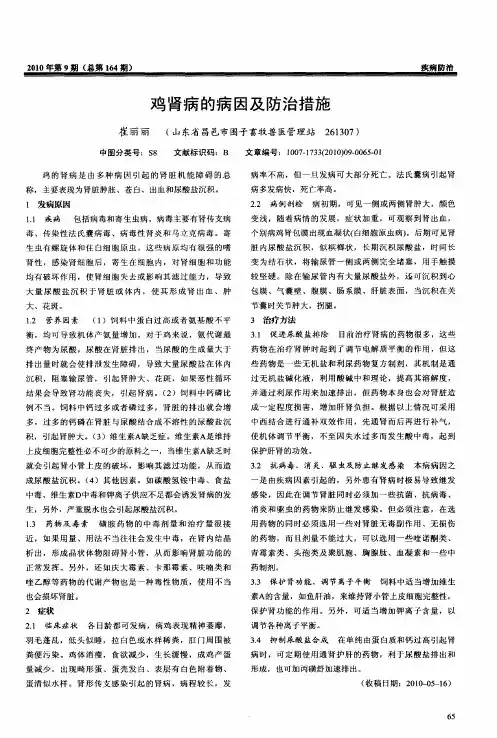
造成家禽肾脏病变的几种常见病的鉴别诊断及防治在临床上经常看到许多病禽的肾脏会在颜色、形状、大小以及肿胀的程度等方面出现多种多样的病变,如鸡的肾型传染性支气管炎、传染性法氏囊病、家禽痛风、维生A缺乏症、磺胺类药物中毒、马立克氏病、淋巴细胞自血病、病毒性肾炎、禽流感等九种疾病均会对肾脏造成各种各样损害和病变,并易造成混淆,现将上述九种禽病的鉴别诊断简述如下。
1肾型传染性支气管炎肾型传染性支气管炎各种年龄的鸡都可发病,但在雏鸡阶段易感,且发病最为严重,最早有在(6-7 }日龄发病的实例。
当鸡舍温度过冷、严寒或过热、拥挤、通风不良、维生素、矿物质和其他营养物质缺乏,以及未按时接种肾型传染性支气管炎疫苗均可促进本病的发生。
在临床上本病可分为四种类型:即呼吸型、肾型、腺胃型、生殖型,其中肾型传支会造成肾脏严重病变,死淘率明显增加。
肾型传支在临床上主要表现为排出多量含有自色尿酸盐的粪便,死亡率很高。
剖检可见肾高度肿大,色变浅r.o粉红色,肾的前叶的形状呈饱满的花生豆样,多数呈斑驳状的花肾,输尿管因尿酸沉积而扩张,呈一条粗白线状,泄殖腔内有一兜自色的尿酸盐,该病的确诊需剖检5只以上病死鸡,其中百分之九卡以上的病死鸡具有上述病理变化即可基本确诊。
2传染性法氏囊病本病是由传染性法氏囊病毒引起一种急性、高度接触性传染病。
主要发生于2一15周龄的雏鸡,而3}6周龄的鸡最易感,也有在180日龄前未开产的鸡患本病的实例。
2.1 }I}床症状本病发病初期会发现有些鸡啄自己的泄殖腔,病鸡羽毛松乱,采食减少,畏寒,常扎堆在一起,精神不振,随即病鸡出现腹泻,排出白色豁稠或水样似牛奶样稀粪,死于传染性法氏囊病的鸡表现为脱水,眼窝下陷,爪干瘪。
2.2病理变化剖检可见胸肌、腿肌有斑点状或刷状出血,法氏囊肿大如玻璃球状,内有灰自色、浅黄绿色液状或戮稠干酪样的分泌物,皱褶水肿有点状或弥漫性出血,严重者法氏囊外观呈紫葡萄样,皱璧严重出血溃疡;腺胃和肌胃连接处靠近腺胃乳头一侧有点状或条状出血带;肾脏有不同程度的肿胀,但肾脏的颜色较正常,严重者呈花斑状,输尿管一般没有显著的病变。
家禽肾脏发病原因及防治措施何立宁(石家庄市畜产品质量检测中心河北石家庄050001)随着养鸡业的迅猛发展,鸡只的肾病已成为鸡病中不可忽视的疾病。
肾病是由多种原因造成的,以肾肿大、出血、肾结石、输尿管结石以及内脏痛风为表现症状,是肾脏机能受损或机能障碍的总称。
不同日龄的鸡只均可发病,轻者鸡只生长发育受阻以及生产性能下降,重者鸡只死亡,给养鸡业造成严重的经济损失。
实践中,无论何种原因造成死亡,死鸡只中常常出现或伴有肾病变,就死亡鸡只而言肾病变可占20%~30%。
1发病因素引起鸡只肾脏疾病的因素很多,概括起来简单可归纳为,疾病、营养、中毒及饲养管理。
1.1疾病因素:疾病病原引起肾脏实质性病变,原有机能丧失,导致大量尿酸盐沉积,甚者引起痛风。
疾病病原有:1)病毒:法氏囊病、传支、马立克氏病、鸡淋巴细胞性白血病、病毒性肾炎等;2)细菌:大肠杆菌、沙门氏菌、葡萄球菌、弯曲杆菌等;3)原虫:球虫、组织滴虫等。
1.2营养因素:1)饲料中蛋白质含量过高;2)维生素A缺乏;3)高钙或钙磷比例不当;4)其它如:NaCl,CuSO4含量过高,NaHCO3添加不当等。
1.3中毒因素:长期添加或添加过量药物造成肾脏损害,药物中毒有磺胺类药物中毒,氨基糖甙类中毒,喹乙醇中毒,痢特灵中毒,土霉素中毒,有机氯、有机磷农药中毒等。
1.4饲养管理因素:1)饮水不足,长时间断水:常见雏鸡不能及时或足够饮水,导致大量尿酸盐沉积。
2)温度过高或过低均可使尿酸盐浓度升高,肾脏负担过重,导致大量尿酸盐沉积。
3)运动不足:如笼养鸡或网养鸡只密度过大等造成运动不足,导致血液中蓄积过量尿酸盐致使血液中尿酸盐溶解性变小,从而沉积于肾脏。
2发病机制2.1当病原微生物侵入鸡体后,鸡体防御系统必然产生抗体抵抗入侵,刺激鸡体产生抗体的病原微生物就是抗原,抗原和抗体形成了抗原抗体结合物,此结合物可在肾脏沉积,导致肾损伤从而发病。
2.2当饲料中营养不均衡(如蛋白含量过高),由于鸡只蛋白质的最终产物是尿酸而不是尿素,如有诱因使肾脏组织细胞遭到破坏,可导致血液中尿酸盐的含量过高,如肾脏不能及时排泄,就在肾脏中沉积。
矿产资源开发利用方案编写内容要求及审查大纲
矿产资源开发利用方案编写内容要求及《矿产资源开发利用方案》审查大纲一、概述
㈠矿区位置、隶属关系和企业性质。
如为改扩建矿山, 应说明矿山现状、
特点及存在的主要问题。
㈡编制依据
(1简述项目前期工作进展情况及与有关方面对项目的意向性协议情况。
(2 列出开发利用方案编制所依据的主要基础性资料的名称。
如经储量管理部门认定的矿区地质勘探报告、选矿试验报告、加工利用试验报告、工程地质初评资料、矿区水文资料和供水资料等。
对改、扩建矿山应有生产实际资料, 如矿山总平面现状图、矿床开拓系统图、采场现状图和主要采选设备清单等。
二、矿产品需求现状和预测
㈠该矿产在国内需求情况和市场供应情况
1、矿产品现状及加工利用趋向。
2、国内近、远期的需求量及主要销向预测。
㈡产品价格分析
1、国内矿产品价格现状。
2、矿产品价格稳定性及变化趋势。
三、矿产资源概况
㈠矿区总体概况
1、矿区总体规划情况。
2、矿区矿产资源概况。
3、该设计与矿区总体开发的关系。
㈡该设计项目的资源概况
1、矿床地质及构造特征。
2、矿床开采技术条件及水文地质条件。